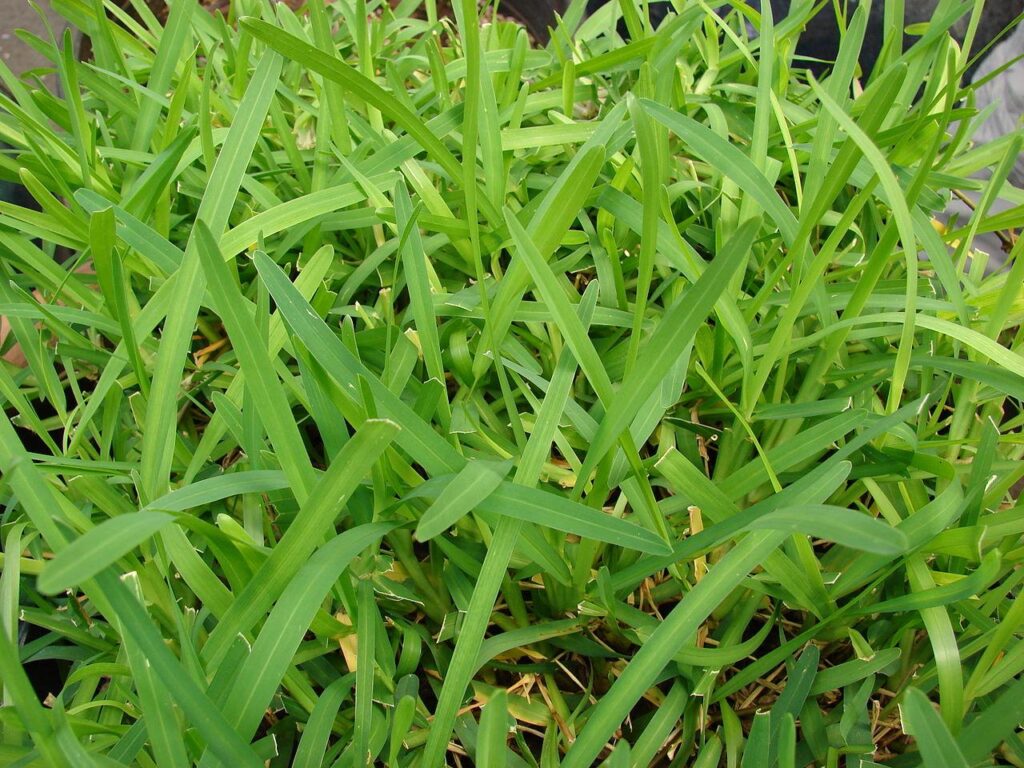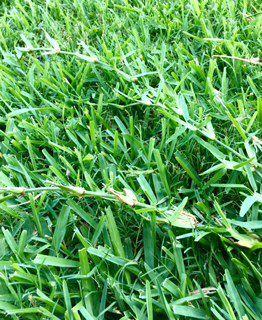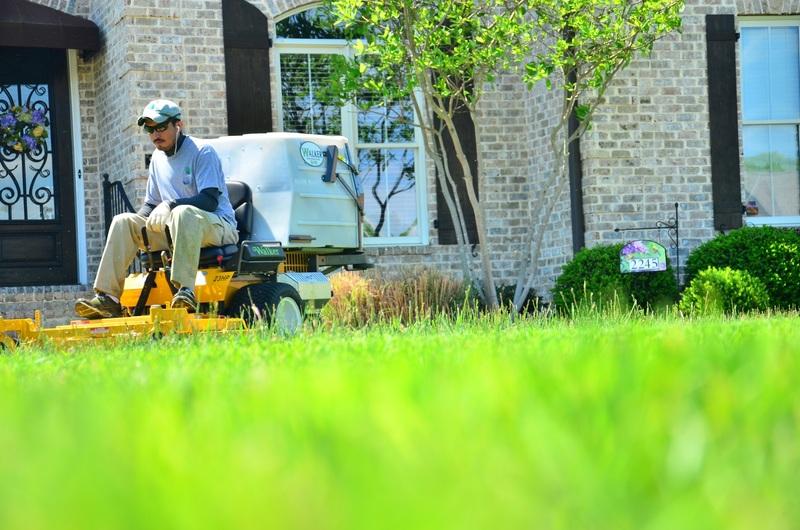If you own a St. Augustine lawn, you might have noticed long branches of St. Augustine grass creeping along the soil surface. These horizontally growing branches are known as St. Augustine grass runners and they can sometimes grow as much as one to two feet in length. St Augustine grass runners become a nuisance if not managed in time. It is because they show up above grass blades, invade patios or driveways and make your lawn look unappealing.

St. Augustine grass blades
Soil compaction is often the main culprit behind Augustine grass runners‘ formation. It is because St. Augustine spreads via above-ground stems known as runners, forming roots wherever the nodes come in contact with the surface of the soil. However, hard-packed soil makes it difficult for the new roots to enter the ground. As a result, tiny roots have a hard time anchoring themselves in the soil, resulting in runner formation.
St. Augustine Grass Overview
St. Augustine holds a special place among warm-season grasses because of its exceptional heat and drought tolerance. The grass has low wear tolerance, so it is not commonly used in sports fields and golf courses. However, this tropical grass is still the turf of choice in the deep south, from Florida to central Texas. It is because St. Augustine’s grass blades are vivid green which adds a nice aesthetic touch to the lawn.
In addition to exceptional drought and heat tolerance, St. Augustine grass also has remarkable salt tolerance, making it ideal for people living along the coast. Here are a few other facts about St. Augustine grass, along with some pros and cons:
St. Augustine Grass Quick Facts
| Scientific name | Stenotaphrum secundatum |
| Other names | Buffalo grass, Charleston grass, Mission grass, Quick grass, Carpet grass |
| Grass-type | Warm-season perennial grass |
| Identification | – Vivid green leaves that round at the top and have a coarse texture – Grows in a dense layer carpeting the ground |
| Shade Tolerance | Moderate |
| Traffic tolerance | Does well in normal traffic |
| pH range | 5.0 to 8.5 |
| Growing Season | – Spring to late summer – Goes dormant when soil temperatures fall below 55 degrees |
| Watering needs | About ¾ inch of water twice per week |
| Common Issues | Diseases – Root rot, Brown patch disease, Grey leaf spot disease Bugs – Grub worms, chinch bugs, sod webworms, and mole crickets Weeds – Chickweed, clover henbit, and dollar weed |
| Pros | – Moderately shade tolerant – Exceptionally heat and drought tolerant – Grows well in a range of soil types and pH – Chokes out weeds easily – Quick post-winter green-up |
| Cons | – Poor cold tolerance – Poor wear tolerance – Excessive thatch buildup – Highly prone to chinch bug infestation |
Now that we know a little bit about St. Augustine grass, we can move on to our main topic. We will tell you everything you need to know about St. Augustine grass runners and what you can do to get rid of them.
RELATED: How To Revive St. Augustine Grass | Why Is My St. Augustine Dying
What Causes St. Augustine Grass Runners?
As already stated, St. Augustine grass spreads by runners that creep on the soil, sprouting roots. St. Augustine runners are especially noticeable in bare spots of the lawn. Often runners grow several feet long, producing roots and grass blades. Usually, runners grow when the roots cannot dig into the soil.
St. Augustine runners are thought to form due to improper mowing height, soil compaction, excessive thatch development, over-fertilization, and heavy pre-emergent herbicide application. Compared to a new lawn, St. Augustine grass runners are hard to spot in a fully established lawn as they grow close to the ground.
Since these runners are stiff, they can rise above the ground when they grow. This results in the formation of floating runners, a phenomenon known as looping.
How Do You Get Rid Of St. Augustine Runners?

Looping in St. Augustine lawn.
In many cases, runner formation or looping is a temporary problem and goes away on its own. However, in some cases, it can persist and create all sorts of issues for your beautiful St. Augustine lawn. To get rid of the looping or runner issue in your St. Augustine grass, you must first identify the core problem. Once you have done that, you can move on towards solving the issue, which will also solve the looping issue in your yard. Here are a few methods that you can use to get rid of unsightly runners from your St. Augustine lawn:
Proper Mowing
The quickest way of getting rid of runners from your grass is to mow the turf. However, you will have to set a proper height for mowing. Also, use vertical mowing instead of horizontal mowing to help you remove the thatch from your lawn.
Another thing to keep in mind while mowing the lawn is to use sharp blades. Dull blades significantly reduce the quality and efficiency of a cut. Improperly cut grass can appear dull and introduce a range of other problems to your lawn.
Core Aeration
Soil compaction is another issue that might result in loops forming on your lawn. A hard-packed soil makes it difficult for the roots to enter and penetrate the soil. As a result, the runner keeps growing without ever connecting to the earth, resulting in runner or looping formation.
The best way to get rid of compaction issues in your St. Augustine lawn is to core aerate it. Aerating the lawn will create spaces between the surface, making it easier for a root to penetrate the ground. Also, aeration will allow the water, nutrients, and air to penetrate deeper in the ground, increasing the resilience of your St. Augustine lawn.
Thatch Removal
Another reason why looping might occur in your St. Augustine lawn is because of excessive thatch buildup. Thatch is a thin layer of organic matter that naturally forms on the grass surface over time. It needs to be removed regularly, or it can prevent the water, nutrients, and air from penetrating the lawn.
In addition to that, thatch can also cause the formation of loops on a St. Augustine lawn. This is because it acts as a natural barrier between the ground and newly forming roots. You can easily get rid of thatch from an Augustine lawn by using a raker or dethatcher.
Thatching can also arise as a result of soil pH problems. SO, make sure that you get a soil test of your lawn which will provide you with tons of information about your lawn soil and any potential pH problems. If the soil is too acidic, you can use agricultural limestone to fix the issue. And if it is too alkaline, you can use sphagnum peat and elemental sulfur to treat the problem.
RELATED: St. Augustine Grass Diseases And Problems | What’s Wrong With My St. Augustine?
Proper Lawn Care

A proper lawn care plan can also significantly reduce grass runner issues on the turf.
Lastly, a proper lawn care plan is the best defense and treatment against looping or runner formation in your St. Augustine lawn. It will also make your lawn more clean, green, and serene. In addition to that, your lawn will become more resilient to lawn diseases, weeds, and bugs. Here’s how you can do it:
- Watering your St. Augustine lawn is critical for proper lawn care. If the lawn is watered carefully, you can avoid a range of potential problems. For instance, too much water can create compaction issues in your yard. So, ensure proper watering to your St. Augustine lawn, and the chances of runner formation will automatically reduce.
- Excessive top dressing over your turf could also create a plethora of problems for your St. Augustine lawns. If used excessively, topdressing materials such as compost can become a barrier between the developing root and the soil. So, be careful while a top dressing of organic layer over your St. Augustine lawns.
- Apply fertilizer to the St. Augustine lawns, particularly during the growing season. First, however, we highly recommend that you get a soil test. It will tell you what nutrients your lawn lacks, and you will be able to choose the best fertilizer solution for your yard.
- Mow your lawn frequently and choose a proper mowing height. Experts suggest that you mow your St. Augustine lawns to around 2½ to 4 inches. However, make sure that you do not remove more than one-third of the leaf blade with any single mowing session.
- Fill in the bare spots of your lawn with sod or grass seed. Using sod will help you achieve a thicker and fuller lawn more quickly. The best time to plant sod is during spring. Grass planted during this time grows more rapidly and efficiently.
Frequently Asked Questions (FAQs)
Can you replant grass runners?
Many grasses spread via above and below ground runners, including St. Augustine grass. Runners can be planted just like seeds to establish a new lawn. You can do it from your front yard to your back yard or on the same lawn to cover the bare spots. There are many ways of doing it. For instance, you can cut a runner with its tiny roots and plant it in a new area.
This method of replanting runners is known as sprigging. Sprigging is a lot cheaper than buying sod. You can do it from your existing St. Augustine lawn or use a friend’s lawn to serve your purpose.
Can I plant stolons or runners?
Runners or stolons are the above-ground stems that can give rise to new plants as they spread across the lawn surface. You can plant runners; however, make sure you do it properly. First of all, dig at least two inches into the soil; however, do not turn over the soil. Next, plant the cut-out runner (sprig) and cover the opening.
Proper care is a must after you plant a runner on your lawn. It includes regular watering and fertilization to give the growing grass a head start. After about two weeks, you can reduce the watering frequency when the cut-out runner has taken hold of the ground.
However, you should keep in mind that planting a new lawn by sprigging is much more labor-intensive and needs a lot of post-care efforts.
How fast do St. Augustine runners grow?
Normally, a newly planted runner takes around two weeks to anchor itself into the new area firmly. After that, it begins to spread and grow itself. St. Augustine grass sprigs usually do not grow as fast as the sprigs of some other grass species, such as Bermuda grass.
It is because St. Augustine grass spreads only by runners. In contrast, Bermuda grass uses runners and rhizomes to spread and grow. Nonetheless, you can still make the St. Augustine grass sprigs grow quicker if you ensure a proper lawn care plan.
Should I pull out grass runners?
It depends on where they are growing and if they are looking aesthetically displeasing. For instance, if they invade the patio area or the driveway near the lawn, it is better to pull them out. However, if the grass runners are developing on a bare spot, it is better to leave them alone as they will establish roots and fill in the empty area over time.
Does St. Augustine grass has runners?
Yes, it does. However, whether or not a particular lawn will develop looping or runners depends on lawn conditions such as soil compaction, aeration, and mowing height.
Sources for Further Reading
- St. Augustinegrass Yearly Maintenance Program. Clemson University Cooperative Extension Service. (2022). Retrieved 10 May 2022, from https://hgic.clemson.edu/factsheet/st-augustinegrass-maintenance-calendar/
- St Augustinegrass. NC State University, Corporate Extension. (2022). Retrieved 10 May 2022, from https://www.turffiles.ncsu.edu/grasses/st-augustinegrass/
- St. Augustine Grass – Gardening Solutions – University of Florida, Institute of Food and Agricultural Sciences. (2022). Retrieved 10 May 2022, from https://gardeningsolutions.ifas.ufl.edu/lawns/turf-types/st-augustinegrass.html
Now that we’ve discussed about St Augustine grass runners, make sure to read our other articles:
Top 10 Super Easy And Effective Ways Of Fixing A Muddy Yard
How To Make Bermuda Grass Thicker, Greener, and Fuller | A Beginners Guide
Why Is My New Sod Turning Brown | How To Keep New Sod From Turning Brown







